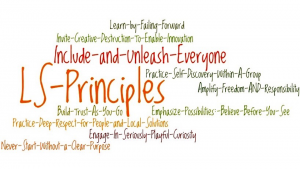In agile context, you might have heard of “fail fast”. Rapidly inspecting and adapting gives you the opportunity to change your mind in case the first idea was not as brilliant as thought of. But “fail forwards”?
Learn by failing forwards is one of the principles of liberating structures. Liberating structures “are meant to supply simple rules that

make it easy to include and unleash everyone in shaping the future”. On the website, you will find a lot of material, and especially a set of about 30 structures (including a matchmaker) that can help you to give structures to meetings or decision forming process.
Going through the principles, you will find “rules governing how we choose to relate to others and statements of our beliefs about what helps create great organizations”. Obviously, they fit rather well into the agile context. But maybe also for other contexts.
Too Much Theory? And Why Should I Care?
That is what the XING Software Test User Group in Hamburg wondered as well, and thanks to guidance by Christian Kram we got the possibility to practice in one of our meetups. Testers and alike frequently get into situations, where they need support by others, and one of the ideas behind the liberating structures formats is based on the experience that the best ideas often come from unexpected sources.
So, we followed the above principles: learn by…. trying a few of the liberating structures without knowing almost anything about them. Christian and Lars Scharrenberg practiced with us the “25/10 Crowd Sourcing” to find topics to talk about, the “Troika Consulting” to improve our listening skills and to help us to help others, and the “15% Solutions” to identify the very first step to DO after all that consulting.
The meetup was very active. I was very glad to see that some usually quieter people started speaking up – to the extend that they improved their self-esteem, finding out they got something relevant and appreciated to say. Lots of experiences have been shared in order to help the topic presenters. Everybody got something to say! Everybody was a potential consultant…
#stughh Vorsellung der Ergebnisse aus der praktischen #liberatingstructures . Alles potentielle Berater hier. 😉
— MaikNog (@MaikNog) June 14, 2018
Also, we had two guests, no testers but interested into the method. Both came back to the organizers noting that these methods even gave them a chance to participate.
And we did have tiny failures as well – one time it would have been better to give different rules for the teams, another time, the structure had been adapted on the fly – which was confusing. In order to fully make use of the structures, it definitely makes sense to practice them, thus building a feedback culture after every step, a trust framework and, learning by failing forwards. In Hamburg for example there is a local Liberating Structures meetup for that.
And What did we Learn Apart from Theory?
Apart from getting an idea about the methods, we all learned something about the testing topics we used to practice the liberating structures. All participants who had their topic discussed, gave a short feedback on what they learned. This seemed to be an extension to the given liberating structures, but a meaningful one. Maybe there is another liberating structure to share the learned, but the evening was late and all have been exhausted as the discussions really required engagement. However, I was glad to hear that many said: I know what I will try to do tomorrow. Hopefully the group will get feedback so that we can participate in celebrating success…
What Was in it For Me?
I am sure I will have to sit back quietly to identify situations to use the structures in my mostly not agile working context. I believe I would need to have people in my meetings, who are open minded for trying out new structures. Maybe in kick off situations, I could give it a try…
Oh, I forgot to explain the beginning statement: Failing forwards? Learn from your mistakes and do not whine around! Do not look back in anger! That is something I definitely can start on tomorrow.
